If you’ve Googled pictures of Iceland, stalked some locals on Instagram (or TikTok I assume, having never used it), or even if you’ve had a recommendation from a friend (possibly the same person you stalked on Instagram), then you’ve likely come across the Icelandic Highlands in some capacity.
Most travellers, and many locals, never really take the opportunity to set foot in this untouched, rugged interior. It’s often because you need the right vehicle, to come at the right time of year (cough: summer), and to be ready to tackle roads and rivers with more fierce courage than that of politicians in a Twitter battle (naming no names).
Waterfalls, mountains, glaciers, hot springs, lava fields, and the ultimate untouched spots for incredible photography, hikes, and adventures; this guide covers it all. Let’s jump in and I’ll walk you through everything you need to know, some hidden tips, and some lesser-known hotspots, of the off-the-beaten-track dreamland of the Icelandic Highlands (you can start packing your
What Are the Icelandic Highlands?
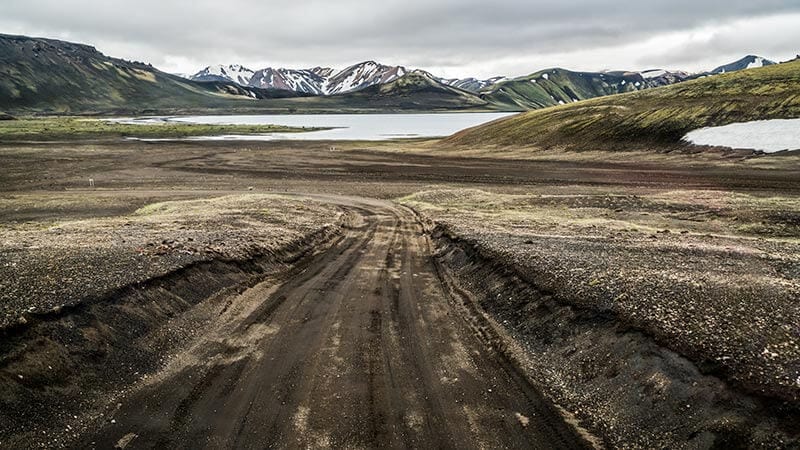
The Icelandic Highlands are the country’s vast, untamed interior, made up of a dramatic and desolate wilderness that covers nearly half the island. Far removed from Iceland’s bustling coastal towns and tourist-filled hotspots, the Highlands are where nature reigns supreme.
This region is shaped by powerful geothermal forces, home to some of the youngest landscapes on Earth, and virtually inaccessible for much of the year (makes you want to see it even more, doesn’t it?) It’s a place where volcanic deserts, glacier tongues, and bubbling hot springs collide, offering a raw adventure for those willing to venture into the heart of the island.
Geography, Size & Geological Significance
Imagine a vast interior plateau so wild and remote it feels like the Moon got a Viking makeover (after all, you are near where NASA astronauts have practiced for missions to Mars). That’s the Highlands. Covering over 40,000 square kilometres, or nearly half the island, the Icelandic Highlands are a true rugged wilderness. But it is a wilderness with hot springs that bubble like they’re trying to cook dinner without you.
Geologically speaking, this is Iceland’s fiery heart. Tectonic plates do a bit of a slow dance here, which means frequent volcanic activity and some of the youngest land formations on the planet. In short: it’s where Iceland gets (even more) dramatic.
Volcanic Origins and Natural Wonders
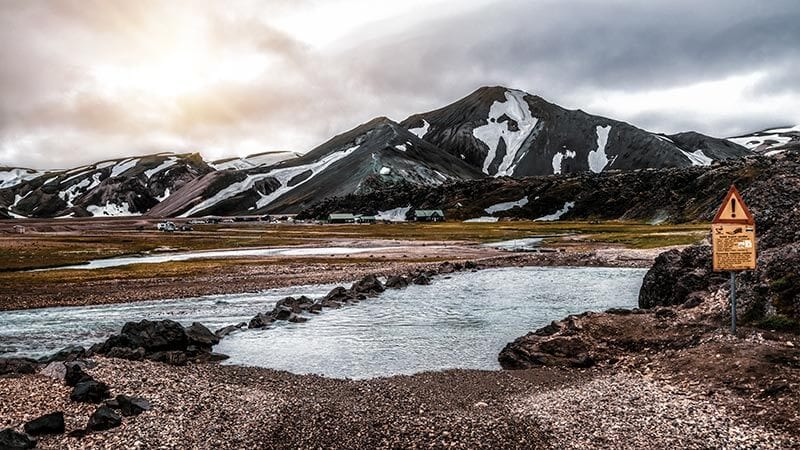
This region wasn’t just made for postcards. It was born in fire and sculpted by ice (literally). Volcanic systems like Bárðarbunga and Grímsvötn dominate, while glaciers like Vatnajökull and Langjökull sneak down from the Highlands, carving valleys and flooding plains.
You’ll find rhyolite mountains in Landmannalaugar glowing pink, red, and yellow; crater lakes like Víti boiling with eerie blue-green water; and steaming geothermal fields like Hveravellir that make the Earth look like it’s exhaling.
Where Are the Highlands Located?
Tucked deep in the centre of Iceland, the Highlands are the country’s untamed wilderness, a sprawling, elevated plateau where paved roads disappear and adventure begins.
While most visitors stick to the coastal Ring Road, the Highlands invite those brave enough to venture inland to discover even wilder landscapes. Reaching them isn’t as simple as typing in a destination into your Google Maps, but for those who make the journey, the reward is unforgettable.
Central Highlands Map & Access Points

Smack bang in the middle of the country, the Highlands stretch between the northern and southern coasts. They’re inaccessible via Route 1 (the Ring Road), so don’t expect to just stumble upon them while chasing waterfalls in South Iceland.
Popular access points include:
- Hvolsvöllur (for Þórsmörk and Fimmvörðuháls): This small town in South Iceland is the primary access point to the lush Þórsmörk valley and the dramatic Fimmvörðuháls hiking trail, which links Þórsmörk with Skógar via a route between two glaciers. From here, adventurous travellers can either hop on a rugged Highland bus or brave the river crossings in a 4×4 to reach this remote and beautiful corner of the Highlands (and don’t worry, we have the perfect Campervans to tackle this journey).
- Hrauneyjar (for Landmannalaugar): Located near the western edge of the Highlands, Hrauneyjar is one of the most convenient gateways to Landmannalaugar. The area serves as a fuel stop and last-chance supply point before entering the wild interior. From here, you can tackle F-roads like F26 and F208, which lead directly into the colourful rhyolite mountains, hiking trails, and geothermal springs of Landmannalaugar. It’s a great staging ground for both day trips and multi-day treks deeper into the Highlands.
- Mývatn area (for Askja and Ódáðahraun): The remote northeast Highlands are best accessed from the Mývatn region (or as I see it, the ‘midge capital of Iceland’), which is a geothermal wonderland in its own right. From here, adventurous travellers can head toward Askja, a dramatic caldera with a warm, turquoise crater lake, and explore the surrounding Ódáðahraun lava desert (yes, that really is a thing), one of the most desolate and unique places in Iceland. The journey requires serious preparation and often several hours of driving on rough F-roads, but the Martian landscapes and solitude make it a truly unforgettable detour.
- Gullfoss area (for Kjölur and Hveravellir): One of the easiest Highland routes to access, the Kjölur route begins near the famous Gullfoss waterfall and cuts straight through the interior between Langjökull and Hofsjökull glaciers. This scenic highland road leads to Hveravellir, a remote geothermal area featuring fumaroles, steaming vents, and a natural hot spring where weary travellers can take a dip and test out becoming a local lobster special. The route is relatively gentle compared to other F-roads, making it a great introduction to Highland driving for first-timers with a 4×4 (in my experience, this can be a great starting route to get your confidence up).
Each entrance comes with its own flavour of adventure. Some involve lunar-like lava plains, others rivers that’ll test your nerves and waterproofing.
Why You Can’t Drive Through Them on Route 1
The Highlands laugh in the face of Route 1 (I like to imagine this is very literal on loud windy days). The Ring Road circles the coast where things are (relatively) tamer. But travelling into the middle of the country? That’s where Iceland keeps its secrets, and its exciting/scary/fun/bumpy F-roads.
These routes are only open during the summer months, typically from late June to early September. Outside that window, you’re either ploughing through snow or stuck in a muddy impasse that nobody will thank you for attempting. During the other months, most F-roads are closed off for driving.
What Are F-Roads?
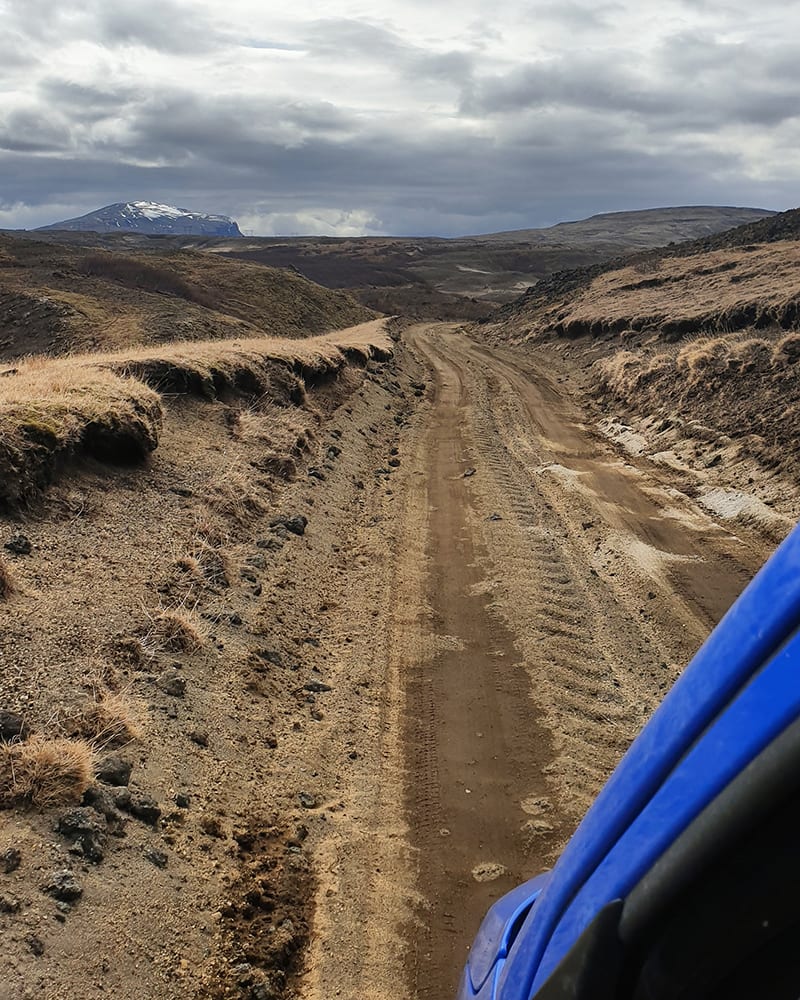 4×4 road leading to Gjain
4×4 road leading to Gjain
If you’ve started researching a road trip through the Icelandic Highlands, you’ve probably come across the term ‘F-road’, and for good reason. These aren’t your standard scenic Sunday drives.
F-roads are Iceland’s official designation for mountain roads, and they mark the true threshold between the easily navigable Ring Road and the wild, volcanic interior. Knowing what they are and how to prepare for them is essential if you’re planning to tackle the Highlands by campervan.
Understanding Iceland’s Highland Roads
F-roads (short for “Fjallvegur” or mountain roads) are rugged trails that often look more like riverbeds than roads. They cross glacial streams, weave through lava fields, and occasionally disappear into the horizon to keep you endlessly on your toes as the driver.
They’re also off-limits to regular cars. Legally, you need a 4×4 to drive them, and trust us, you’ll need it. Suspension, clearance, and traction are not optional luxuries here, they’re survival tools. And, by the end of this driving experience, all the Top Gear specials will feel like a breeze.
What You Need to Know Before Driving on F-Roads
F-roads aren’t graded or regularly maintained. That means you’re dealing with rough surfaces that change with the seasons, and sometimes by the week or even by the day in my experience.
Landslides, river swell, loose gravel, and weather erosion can dramatically alter the condition of these roads. Unlike paved routes, there’s no guarantee you’ll find signage, barriers, or warning lights. You need to rely on your own judgement, up-to-date reports, and a healthy respect for nature’s unpredictability. Expect:
- Sharp rocks
- Deep potholes
- Narrow single-lane passes
- River crossings
It’s essential to check road conditions at road.is and monitor the weather at vedur.is before venturing in. Conditions can change faster than you can say “Did that rock just move?”. But, don’t fear the obstacles, they simply part of the Iceland travel experience, and what make the really awesome stories you’ll tell tales about in the years to come (yes, they are the ultimate storytoppers).
River Crossings and Rough Terrain Tips

River crossings are where things get real. These are not shallow puddles you can splash through with a smile, some are knee-deep, fast-moving torrents fed by glaciers that shift with the weather. Misjudge one, and you could flood your engine or get stranded in the middle of nowhere, which often leaves travellers stuck making that awkward phone call to the emergency services.
Even experienced locals treat river crossings with caution. Always stop, assess, and if in doubt, wait for another vehicle to cross first or turn back. At every crossing, there are signs with clear explanations of the water height, the right paths to take, and tips for maintaining a constant speed (you’re not James Bond). It requires a lot of focus and at some points, steel nerve to get through, so make sure your travel wingman is helping you by keeping an eye on the water level and monitoring better options. In short, always:
- Walk the river first if unsure
- Cross at shallow, calm sections
- Drive slowly in a low gear (usually around 5km/h)
- Never cross if the water reaches above your wheels or looks like it could sweep away your camper (which it absolutely can if the conditions are bad)
If you’re not confident, turn back. Iceland’s rivers do not negotiate, and like with everything in Iceland, the nature can be incredibly unpredictable.
How to Explore the Highlands of Iceland
When it comes to getting around the Highlands, your choices are delightfully limited, in a good way. This part of Iceland isn’t about coach tours and paved highways. It’s about freedom, challenge, and the kind of roads that make your steering wheel sweat (and your palms if you’re anything like me). Whether you’re behind the wheel of a 4×4 campervan or letting a local expert do the driving, how you choose to explore can make or break your adventure.
Self-Drive vs Guided Tours
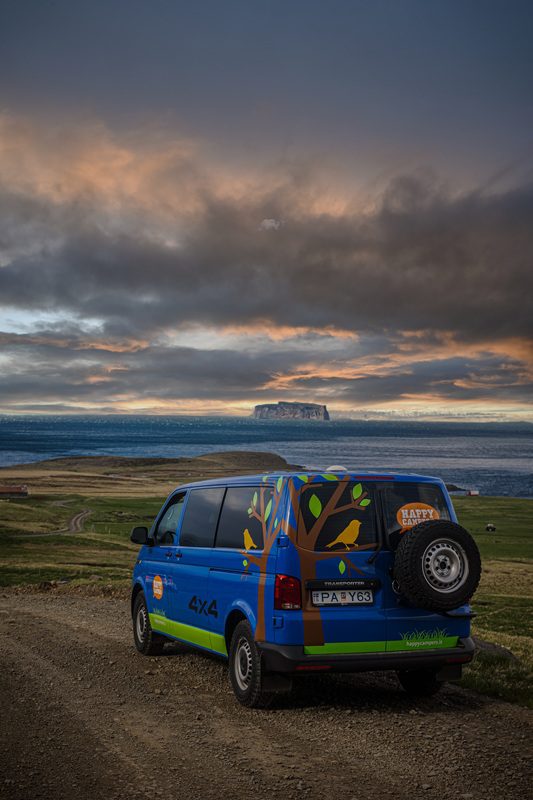
There’s no one-size-fits-all way to explore the Highlands, and that’s kind of the point. Whether you’re after the thrill of navigating river crossings on your own or prefer to sit back and focus on gazing out the window, your travel style will shape your experience. Understanding the pros and cons of self-drive versus guided tours will help you choose the right adventure for your comfort level, skillset, and schedule.
Pros and Cons of Each Approach
Self-Drive:
Pros: Total freedom, more time to explore, save money if you’re already renting a campervan
Cons: High risk, requires planning, not all areas accessible depending on weather and river levels
Guided Tours:
Pros: Expert drivers, access to restricted zones, zero stress
Cons: Less flexibility, group schedules, costs more per day
Who Should Consider Guided Highland Tours?
If you’re travelling solo, nervous about off-road driving, or visiting early or late in the season when road conditions can be sketchier than y bank balance at the end of the month, join a guided tour. It’s also a good idea for families or those short on time who want to tick off several big sights but feel a little over-stressed or anxious about another thing to think of.
Vehicle Requirements for Highland Travel
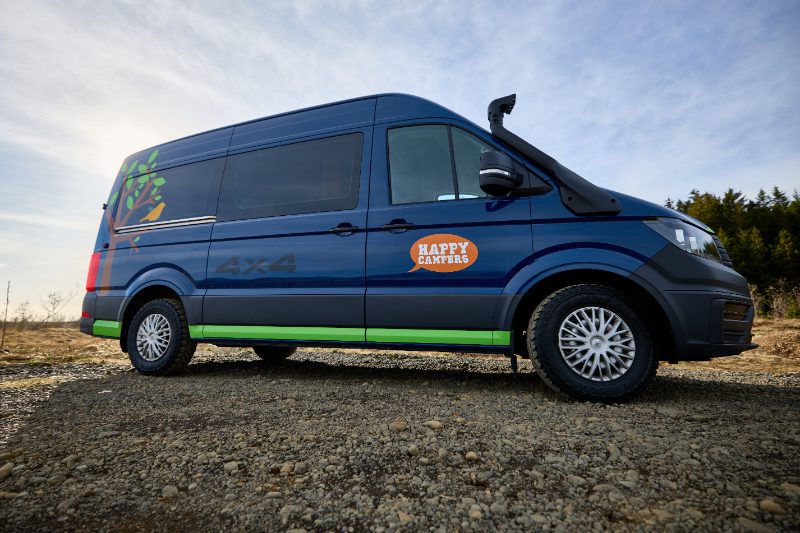
Before you even think about heading into the Highlands, make sure your ride is up for the challenge. This isn’t the kind of place where you can wing it with a hatchback and hope for the best (seen it, and that car’s suspension won’t come back).
The combination of rough gravel, river crossings, steep gradients, and remote terrain demands a vehicle built for more than just sightseeing. Your choice of campervan or 4×4 can mean the difference between an epic road trip and a very expensive rescue mission. Let’s break down exactly what kind of wheels you need to take on Iceland’s wild wild centre.
Why You Need a 4×4
Legally, F-roads require a 4×4. But even if it wasn’t the law, you’d want one anyway. These roads are no joke. The terrain will chew up a sedan and spit it into a lava field, and you’ll be lucky if you don’t end up needing a tow from a Super Jeep driven by a smug local rolling his eyes.
Choose something like the Happy 4×4 or Happy 4×4 XL. These beasts are built for the job with higher ground clearance, strong suspension, and tyres ready to bite into volcanic gravel.
They’re designed by our team specifically for these rugged landscapes and river crossings, giving you the confidence to explore without second-guessing every bump in the road. You’ll not only be safer, you’ll also have a much better time knowing your vehicle is made for the madness, having been tried and tested by our enthusiastic team numerous times before.
Insurance Tips & Safety Warnings
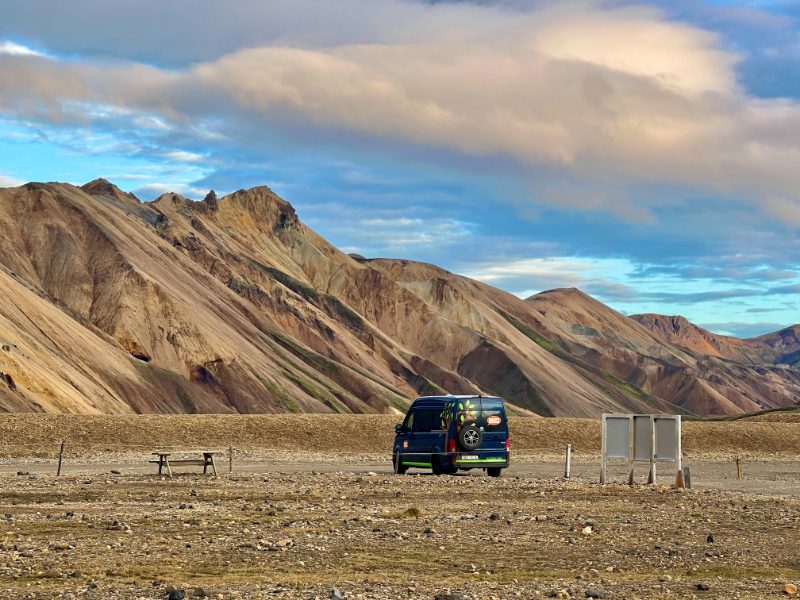
With Happy Campers, every rental includes basic protection: Collision Damage Waiver (CDW) and Third-Party Liability (TPL), but Highland travel demands extra security. For a safe, stress-free Highland driving experience, consider these key options:
CDW & TPL (included): CDW limits your liability in case of an accident, with a deductible of €2,500. TPL covers damage you may cause to others.
Gravel Protection (€10/day): Covers windscreen and headlight damage from gravel, which is a common hazard on Highland roads, as you can imagine.
Tire Insurance (€10/day): Replaces tyres damaged by punctures or rough terrain. A smart choice for rocky trails.
Sand & Ash Insurance (€5/day): Covers damage caused by volcanic ash or sandstorms, with a reduced deductible of €1,000.
Premium Insurance (€35/day): A bundle that includes gravel, tire, sand/ash, theft, and minor scratch coverage, with a lower €600 deductible.
Premium+ Insurance (€55/day): Provides full coverage with a zero deductible, including windscreen, rims, theft, and roadside assistance.
Happy Bundles:
- Happy: Basic add-ons like gravel and tire protection.
- Happier: Includes Premium Insurance and extra gear.
- Happiest: All optional extras plus Premium+ protection.
Why this matters in the Highlands
Highland driving brings gravel chips, flat tyres, ash storms, and river crossings (but, I totally swear it’s worth it!) Without the right cover, your base insurance won’t help with:
- Windscreen or headlight damage
- Tyre or rim damage
- Ash or sand abrasion
- Water submersion (e.g. from unbridged river crossings)
We recommend Premium+ or the Happiest Bundle for peace of mind, especially if you’re venturing into deep Highland territory. When you pick up your campervan, our team will go over your route and help you choose the best protection for your journey. Remember the team is here to help. We want to see you back happy and pumped, fist-pumping us for our awesome ideas!
Fuel, Food, and Emergency Prep
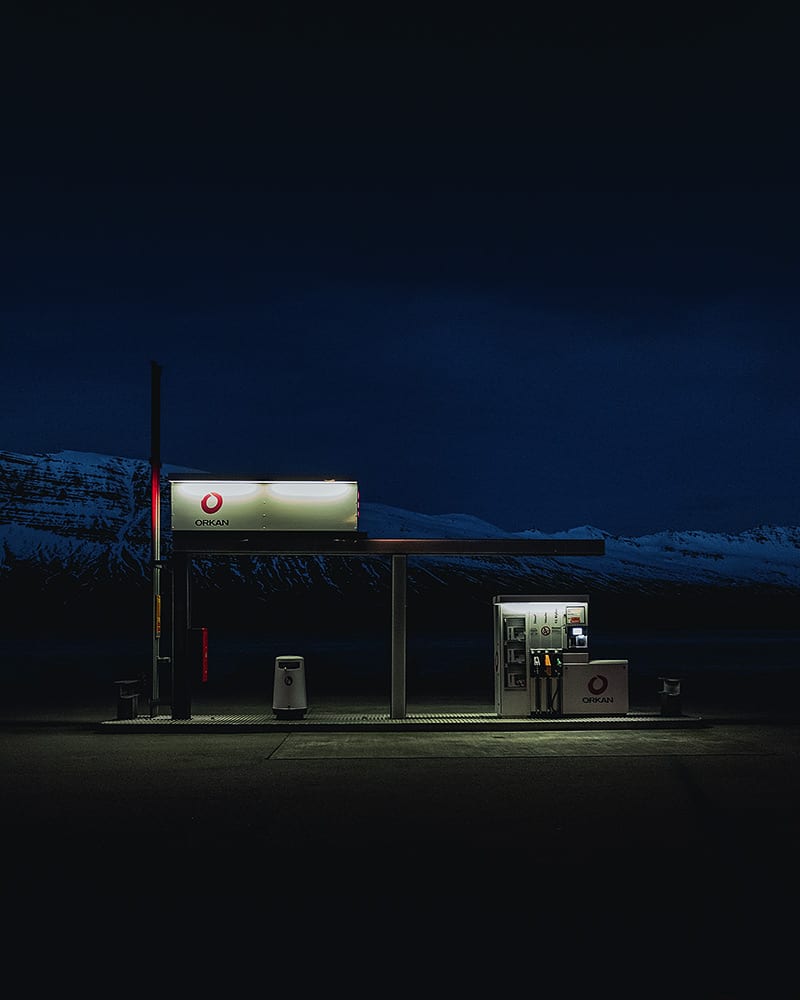
Petrol stations are sparse. Always fill up before entering the Highlands and carry extra if your tank is small.
Make sure to pack the following:
- Food for at least two days
- Extra water
- Emergency battery or power bank
Physical map (GPS might conk out)
The Highlands are incredible, but only if you’re prepared. Remember you can charge most of your devices with the power outlets in your Happy Camper campervan (home on wheels) while you’re trundling through the next landscape. Although I’m saying this for safety reasons, it’s also the main way I can ensure I have the option of a Netflix film cuddled up in the evening.
When Is the Best Time to Visit the Highlands?
Late June to early September is your window. Before or after that and the roads are often closed, impassable, or straight up buried under snow. This short summer season is when Iceland’s rural tundra opens its gates to explorers, and it’s essential to time your trip right to avoid road closures or dangerous conditions (as best you can, of course).
July offers the best weather and driest roads, while August is prime for photography with golden light and late-summer colours. June, though beautiful, can still hold onto snow in the higher elevations, and September often marks the start of closures depending on weather.
In truth, as long as you’re choosing a summer month, you won’t be disappointed, generally speaking. Travellers often forget that during this time of year, we are also experiencing the Midnight Sun, which allows you to travel at basically any hour of the day with decent visibility, so you can also relax a little if you’re travelling with an intense planner (like me…unless she’s reading).
Top Places to Visit in the Highlands of Iceland
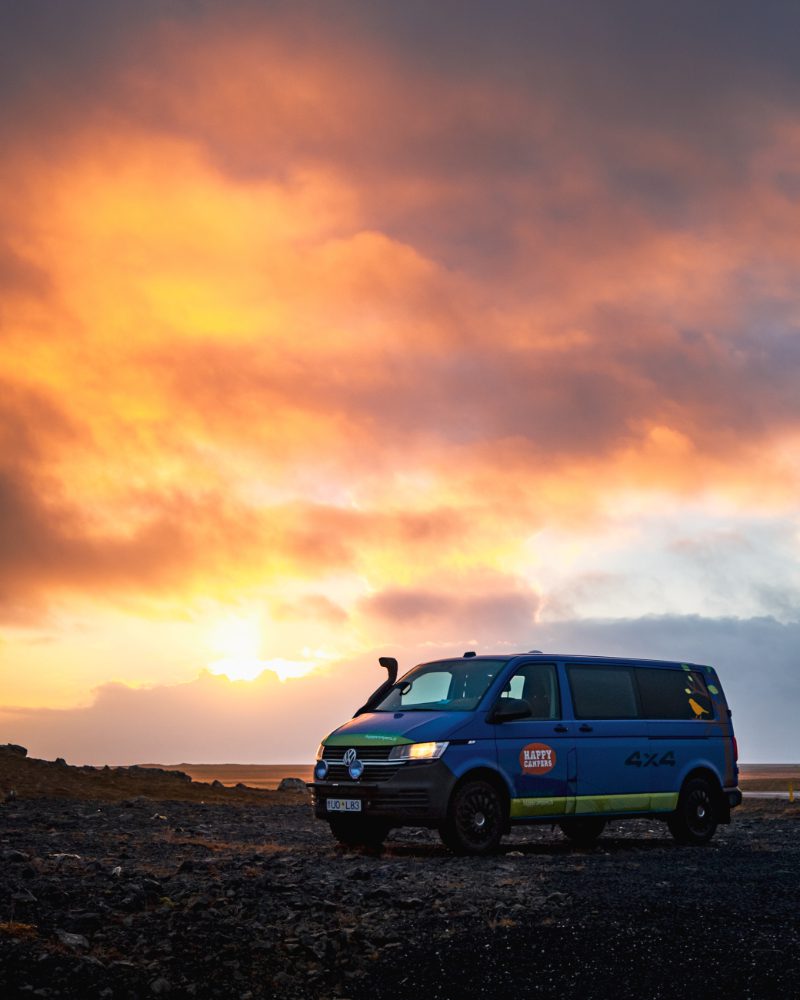
The Highlands aren’t about hitting every major tourist site, instead, they’re about discovering raw, remote, and ridiculously photogenic landscapes that fill up your phone memory. If you’re wondering where to start, this next section highlights some of the most breathtaking and unique destinations that show off the Icelandic Highlands at their wildest. From steaming geothermal valleys to ice-covered calderas that pack a serious punch, these are my recommended stop-offs within Iceland’s interior.
1. Landmannalaugar
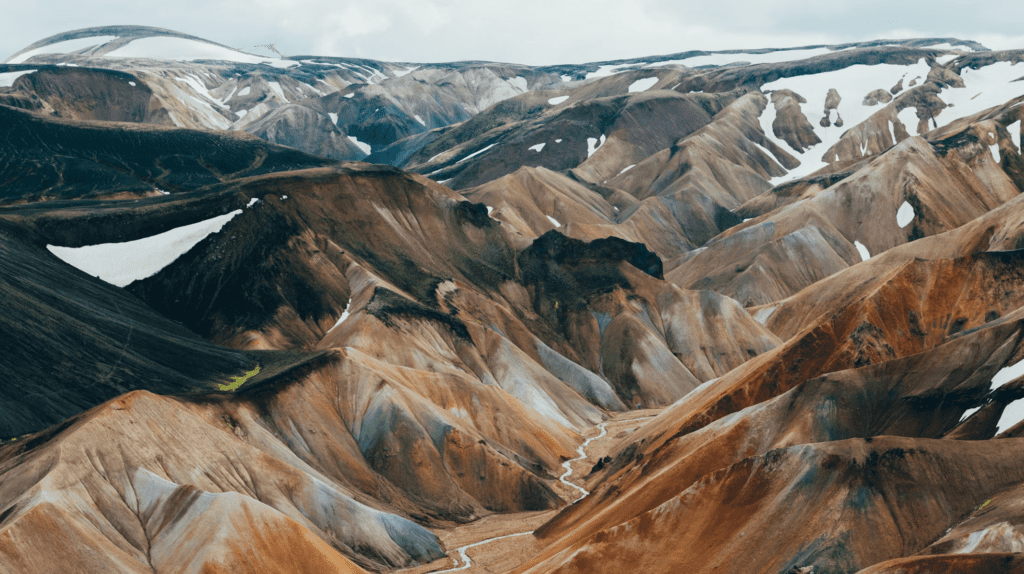
Rainbow-coloured mountains. Lava fields. A hot spring that feels like nature’s own spa. Landmannalaugar is the Highlands’ superstar and one of the most accessible via F-roads. It’s a hiker’s paradise and the starting point of the famous Laugavegur Trail, which is a multi-day trek that showcases some of Iceland’s most jaw-dropping terrain (there’s even a marathon along this trail if you’re that way inclined).
This region is a geological wonderland, shaped by centuries of volcanic activity and home to vibrant rhyolite peaks that shift in colour depending on the light. The lava fields here, like Laugahraun, are hauntingly beautiful, and the area’s geothermal activity adds a sense of ancient, simmering energy to every trail.
Don’t miss the Brennisteinsalda hike and definitely pack your swimsuit. Soaking in the geothermal hot spring here is practically a rite of passage and one of the most iconic Highland experiences. Landmannalaugar is also one of our top recommended camping destinations with an incredible environment and unexpectedly good facilities.
For those of you I’ve scared above about river crossings, you can easily park before the river here (it’s usually recommended) and simply walk the 10 minutes across to the campsite (or brave it like a legend!)
2. Askja & Víti Crater
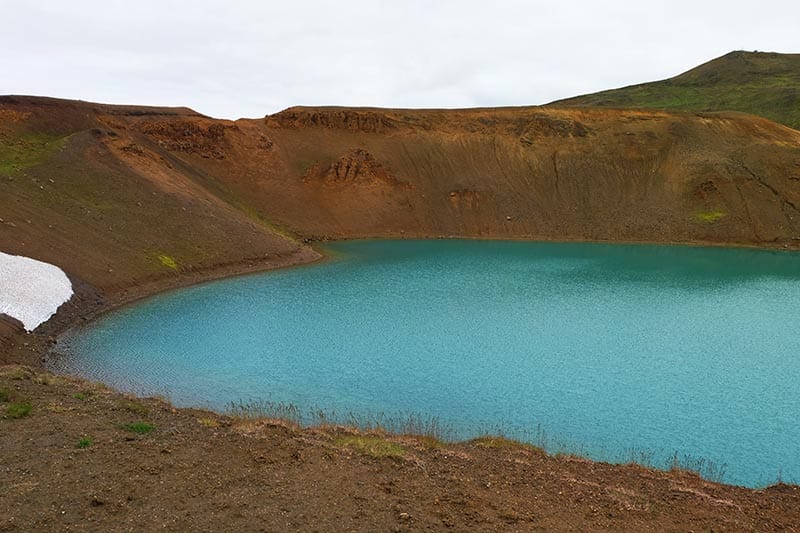
A desolate moonscape where NASA literally trained astronauts. Askja is hauntingly beautiful and home to the Víti explosion crater (sound promising, right?) It’s filled with warm, opaque water that some brave souls even swim in. We won’t name names, but yes, it’s technically allowed if conditions are safe and you’re feeling brave (and chilly). After all, there’s nothing quite like bathing in an active volcano’s caldera…
The drive here is long and rugged but unforgettable, taking you across vast lava deserts and scenes you’ll likely see in future sci-fi hits (and flops). You’ll pass the Ódáðahraun lava field (Iceland’s largest) and feel like you’ve left Earth entirely. This is a true test of your Highland mettle. Bring food, fuel, layers, and nerves of steel, and be ready for a full day of exploration and grit. Even in summer, snowfields can linger nearby, and the weather can change faster than a certain billionaire’s temperament on Twitter (again, I’m not saying any names!)
3. Langjökull Glacier
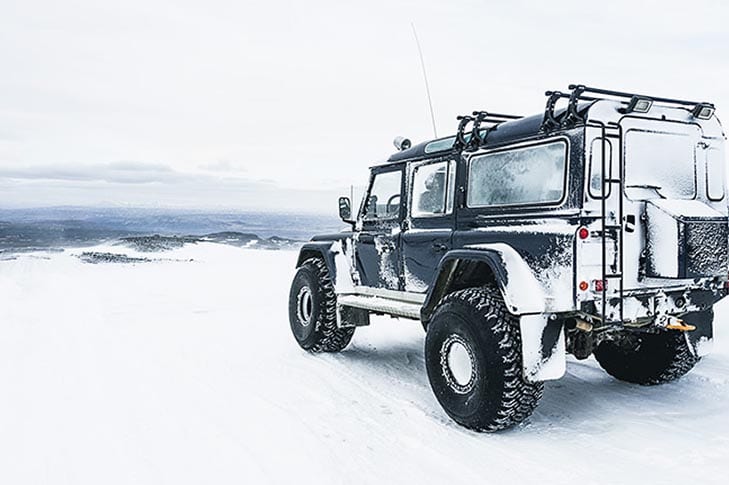
Iceland’s second-largest glacier offers everything from snowmobiling to ice cave tours. With vast fields of ancient ice, dramatic crevasses, and sweeping views of the surrounding Highlands, Langjökull is a surreal stop on any Highland itinerary. You can even venture inside it (literally) thanks to man-made ice tunnels that let you walk through the beating (thawing) heart of the glacier.
And with its location near the Kjölur Highland route, it’s a great add-on to a Central Highlands trip, especially for those looking to balance rugged road adventure with frozen wonders.
4. Hveravellir Nature Reserve
Right between Langjökull and Hofsjökull lies this geothermal oasis (not the band). Hveravellir is a wild combo of bubbling mud pots, colourful hot springs, and remote mountain huts. It’s a great spot to relax in nature after hours of bumpy roads, offering both a visual feast and a much-needed breather from the volcanic grind.
The surrounding trails lead you through steam vents and past sulphur-stained rocks, with sweeping views of Iceland’s glacial giants looming on the horizon. The solitude here is palpable, broken only by the hiss of the earth and the crunch of boots on gravel.
There’s even a small natural hot pool to soak in if you time it right, which offers the perfect reward after a day of wind, dust, and awe. Given the location of this reserve, you can often find yourself with most of the day to yourself, which is perfect if you’re a traveller like me lost in a podcast on a hike.
5. Kerlingarfjöll & Hveradalir
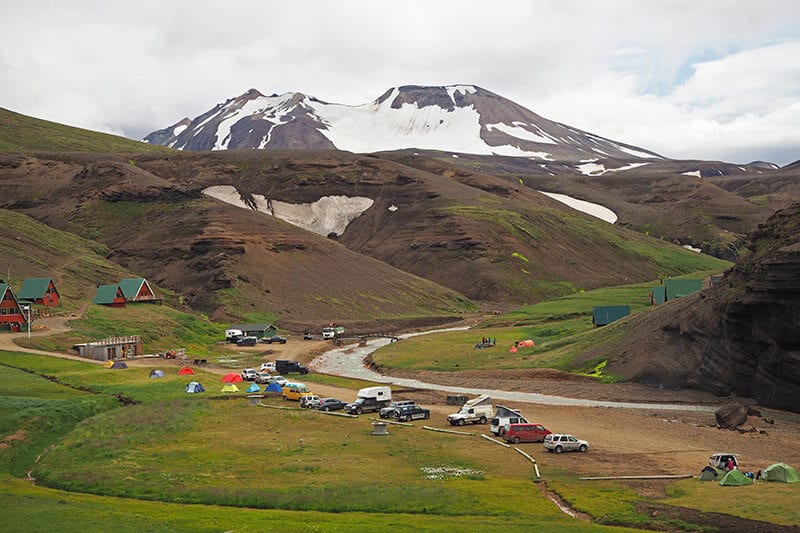
Imagine hiking through steaming orange hills while mist dances off boiling streams. Kerlingarfjöll is like Mother Earth decided to experiment with neon paints and boiling kettles, creating a visual symphony of colour, heat, and geological wonder that I think would inspire Picasso, himself.
The trails are steep but rewarding, snaking through grandiose terrain shaped by millennia of volcanic activity (just like the best bits of Iceland are!) With every step, the ground murmurs beneath your boots, and the scent of sulfur mixes with crisp mountain air. You might feel like you’re walking through a dreamscape conjured by a mad geologist. And, if you’re a geology nerd or just love rocks? Then, trust me, this is the perfect hike for you.
Rest up at the Highland Base campsite and crack open a few treats from your last visit to the Vínbúðin whilst you scroll through your camera roll. Also, lift your head a little, so you don’t miss the sunrise cast golden light over steaming ravines and red-streaked ridges, which is a moment you won’t forget.
6. Þórsmörk Nature Reserve
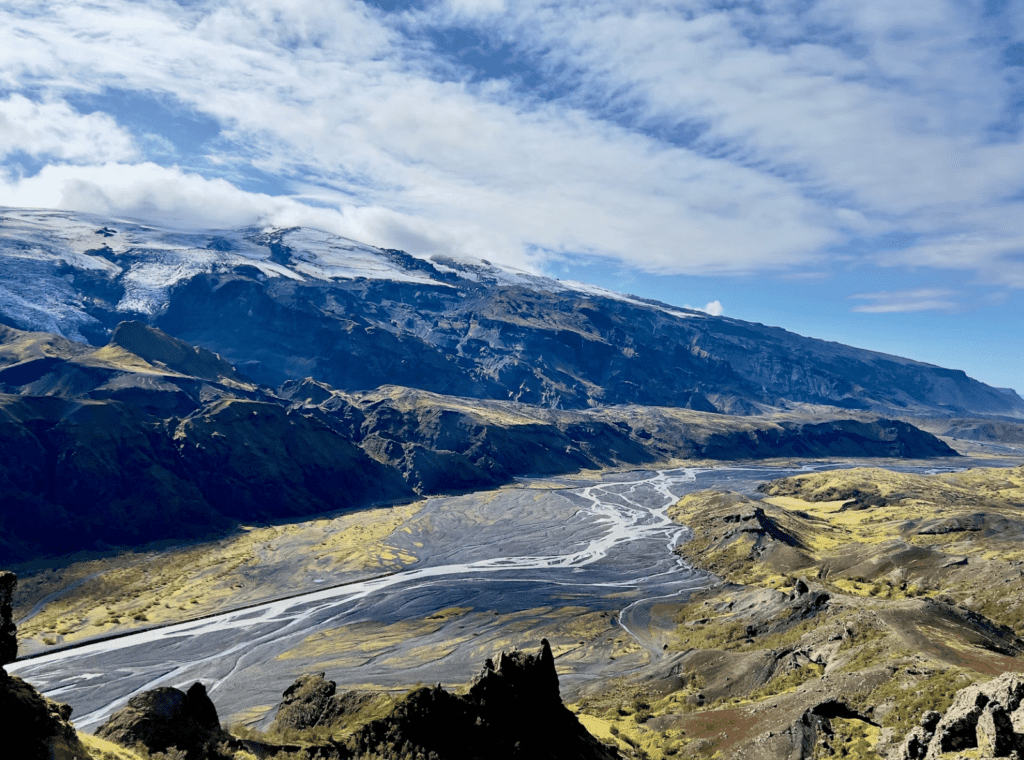
Tucked between glaciers and only accessible via river crossings, Þórsmörk is like something out of a fantasy novel. Dense birch forests, winding trails, and views of icy peaks from the towering glacier tongues nearby. In summer, it bursts with green life, contrasting starkly with the volcanic terrain that surrounds it, making it feel like a hidden valley straight out of Norse mythology.
It’s also the endpoint of the Laugavegur Trail, so combine it with Landmannalaugar if you’re up for a longer adventure. The route between the two offers a journey through colourful mountains, black sands, hidden waterfalls, and steaming vents, making it arguably Iceland’s most iconic multi-day trek for those lucky enough to have discovered this travel guide!
Tips for Adventuring in the Icelandic Highlands
Before you hit the road, or the trail, into the Icelandic Highlands, it pays to know what you’re getting into. This isn’t a drive to remake the Fast & Furious Vin Diesel movies, or a walk in the park. The Highlands are remote, wild, and unlike anywhere else in Iceland. That’s part of the appeal, of course, but it also means you’ll need to plan smart, pack right, and expect the unexpected.
This section dives into the essential tips that can make or break your adventure, from road safety and hiking prep to camping know-how and respecting the delicate natural environment.
Driving in the Highlands
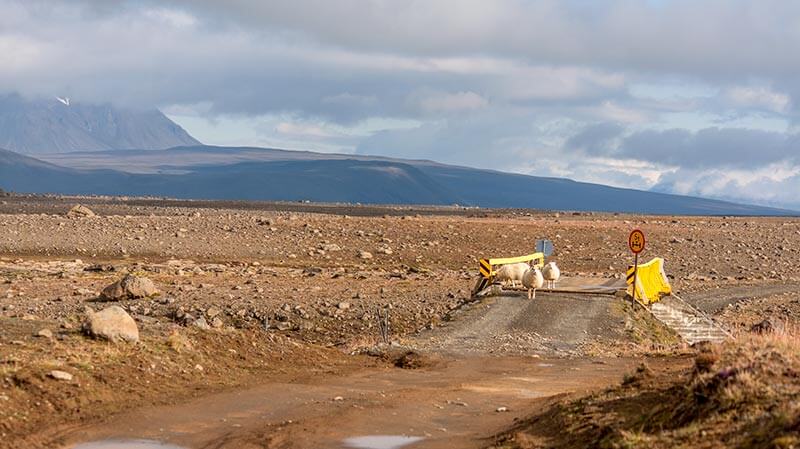
Driving here isn’t your usual cruise along the coast with puffins photobombing your windscreen. It’s rocky, remote, and ridiculously scenic, but also not very forgiving if you make bad decisions. Go slow, give the terrain your full attention, and never assume the road will stay nice just because it started out friendly.
Plan for unpredictability: river levels can rise within hours, visibility can drop in minutes, and that ‘easy’ track can suddenly turn into a rock-strewn endurance test. Take regular breaks to assess road conditions and never push forward just because you’re ‘almost there.’
Always check road conditions and weather updates before setting off, as I mention in all of my guides. Bring a physical map as backup, or download some maps onto your phone before delving into the unknown. It’s also smart to let someone know where you’re headed and when you expect to return, because if anything goes sideways, help could be hours away. You can log your plans on the SafeTravel App where you can log your plans, or even link your phone’s GPS to it, so help is on the way if you need it.
Highland Hiking Safety
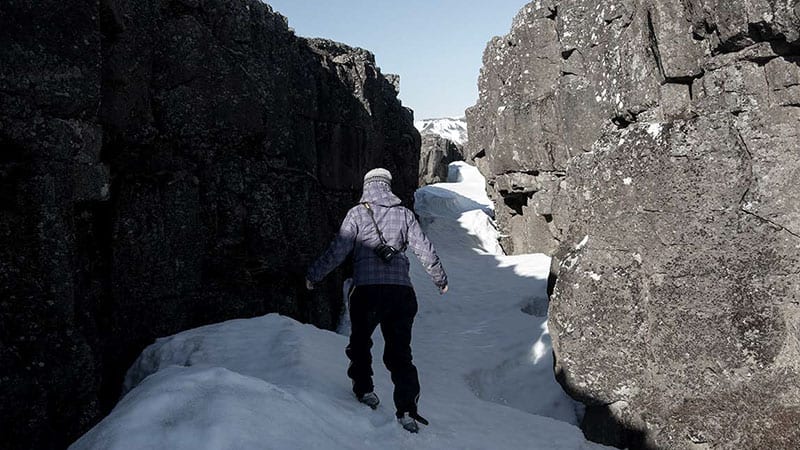
Trails in the Highlands range from short scenic routes to multi-day expeditions. Sorry to sound like I’m repeating myself, but the weather can change in a heartbeat, so always dress like an onion, with multiple layers, a waterproof jacket and trousers, good boots, and food for the day. Don’t hike alone unless you’re a pro with a personal EPIRB and a suspicious lack of fear (or you happen to be my brother, who we need to put a bell on with his number of wanders).
Remember, the terrain can range from soft volcanic soil to jagged lava and slippery stream crossings, so sturdy footwear and trekking poles are your best friends. It’s also wise to start early, not just to beat the weather, but to give yourself buffer time in case conditions change mid-hike.
Tell someone your route. Or again, log it with the SafeTravel App. After all, your mobile signal can be as reliable out here as a drunk puffin.
Camping in the Highlands
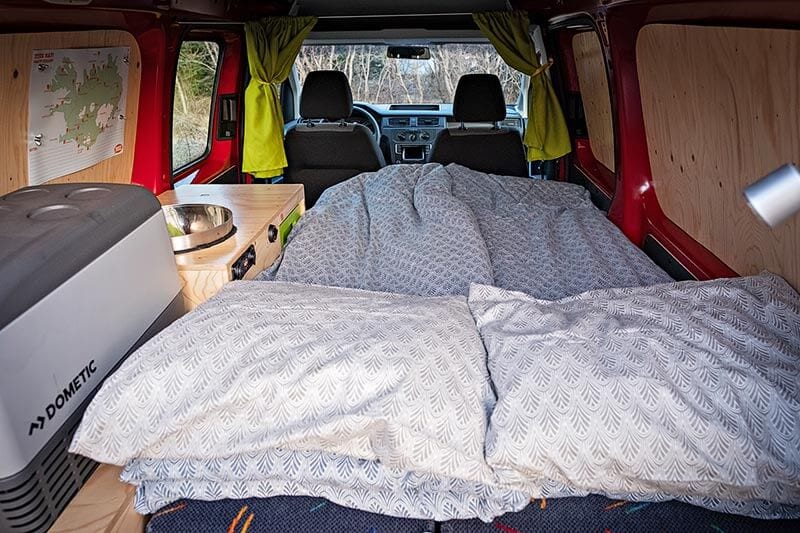
Some areas offer basic campsites, but many are remote and wild-feeling. Facilities vary from rustic huts to nothing but grass and wind. Don’t expect as many facilities as the campsites you’re likely more accustomed to along the ring road. You’re on nature’s terms out here, and that’s part of the appeal, but it also means being properly prepared (Bear Grylls time). You’ll want to bring:
- Your own food and gas (all of our campervans have a portable gas cooker)
- Plenty of water
- Waste bags (leave no trace!)
- Warm sleeping bags
You can check our camping gear extras to help you see what’s included with our campervans, free of charge, and where you can add some extras, like a guitar to channel your inner rustic Ed Sheeran.
Wildlife & Nature Etiquette
You might spot Arctic foxes, wild geese, and the occasional sheep looking personally offended by your presence (they show this by regularly running in front of your camper). These animals are part of the Highlands’ delicate ecosystem, and human interference can disrupt their natural behaviours. Don’t feed them. Don’t chase them. And for the love of Björk, don’t litter.
Stick to marked trails to avoid damaging fragile landscapes, especially the iconic moss that covers lava fields, which grows slower than your Icelandic pronunciation and can take decades to recover if disturbed. Respect nesting birds by giving them space, and resist the urge to ‘go off trail’ for that perfect Instagram story. Follow the golden rule of Iceland: take only photos, leave only tyre tracks (and even those should be minimal).
Our Recommended Highland Road Trip Itineraries

3-Day Highland Highlights Loop
Perfect for those short on time but big on ambition. Start from Reykjavík, drive east to Landmannalaugar, loop north to Hveravellir via the F26, and cut west toward Gullfoss. It’s intense, but you’ll hit thermal valleys, lava fields, and moonscapes in one go.
Expect dramatic contrasts of colourful rhyolite mountains, black lava plains, and geothermal steam rising from the earth as you drive. While it’s a (relatively) fast-paced route, each stop packs a visual punch. Be prepared for long days, rough roads, and unforgettable scenery.
5-Day Hiker’s Dream Itinerary
If you want time to explore on foot, take five days to journey from Þórsmörk to Kerlingarfjöll, Landmannalaugar, and Hveradalir. Stay at mountain huts or remote campsites, and give yourself time to actually breathe in the views.
This route offers a balanced mix of easy but spectacular trekking, geothermal magic, and surreal volcanic landscapes. It’s perfect for those who want to lace up their boots and truly connect with Iceland’s wild(er) side, without rushing from one viewpoint to the next.
Add-On to a Classic Ring Road Journey
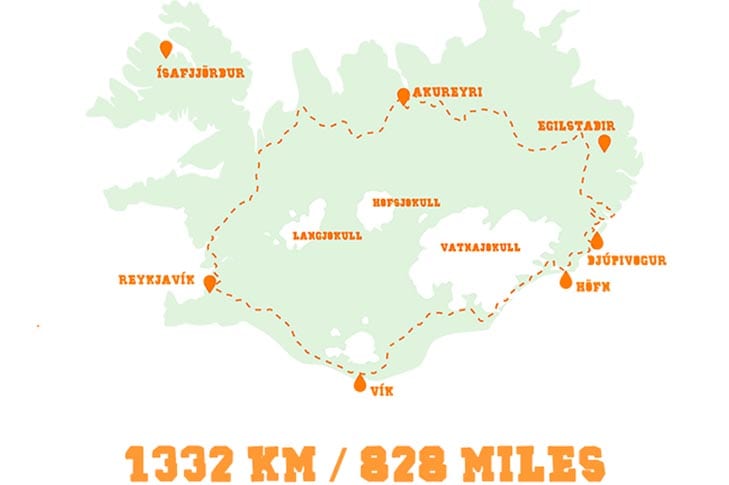
If you’re already planning to drive the Ring Road, then consider taking a three-day detour into the Highlands between Akureyri and Reykjavík. Head in through Sprengisandur or Kjölur, loop past Askja or Hveravellir, then rejoin Route 1 like the explorer you are, or if it’s a mistaken right turn, then what a mistake!
This is ideal if you want a touch of the wild without skipping the rest of the island. It’s the perfect way to spice up a Ring Road itinerary with some rugged interior adventure. You’ll drive through lava fields, glacier views, and geothermal gems, then pop back out to civilisation like you never even left, only dustier, bolder, with far better photos, and a campervan blackened in the ash of ancient eruptions (pretty badass!)
Conclusion: Is a Trip to the Highlands Right for You?
If you want hotel room service and pristine roads, then the Icelandic Highlands are not for you. But if you want raw, cinematic adventure, geothermal soaks in places you can’t pronounce, and landscapes that make you question your reality, then yeah, the Highlands are calling.
It’s not always comfortable. You’ll probably get wet. You’ll definitely get dusty. And at some point, you’ll wonder if that bump in the road was a rock or just a grumpy troll having a nap.
But trust me, when you’re soaking in a wild hot spring like Landmannalaugar under the midnight sun, you’ll know this was worth every muddy tyre and every pothole (well, most).
So, if you’re ready to go off the grid? Book your 4×4 campervan and let Iceland’s Highlands do what they do best, absolutely blow your mind (send us pics!)
Back